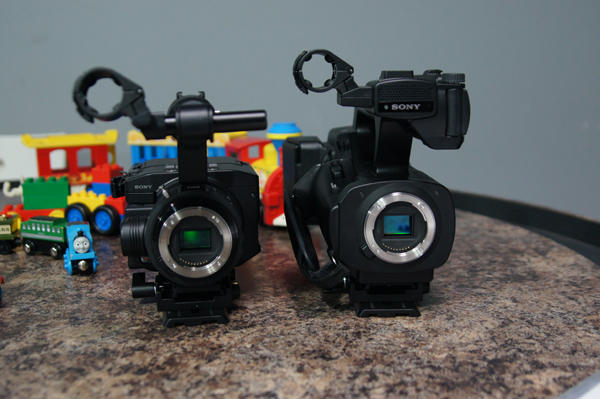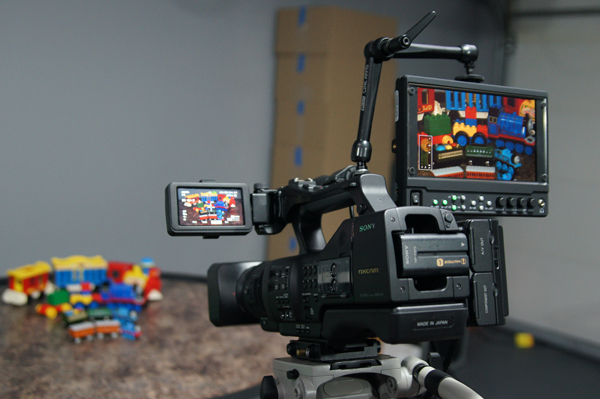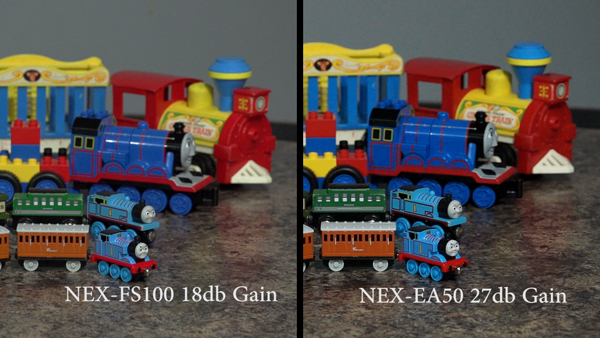Sony NEX-EA50 vs. Sony NEX-FS100 (and the Parfocal 3x+ Zoom Challenge)
Shawn Lam compares key models in Sony's large-sensor camcorder line--the new shouldermount NEX-EA50, and the comparatively venerable handheld FS100 and FS700--with an eye to light sensitivity, image quality, and effectiveness with power zoom lenses, and reports on his epic, ongoing search for a viable parfocal 3x+ servo zoom lens.
EA50 Sensor
The sensor on the EA50 is an APS-C photo sensor--the type found on the Sony NEX photo cameras, and not the Super35mm video sensor that is found on the Sony NEXFS100/700 models. Natively, the sensor is 16MP. It can even take 16MP photos on the EA50 but I didn't test the photo functionality.

Sony FS100 with Super35mm sensor on left and Sony EA50 with APS-C sensor on right.
Theoretically, this means that the camera oversamples, resulting in a slightly-less-than-2MP 1080 HD video signal, and would make it more prone to moiré and aliasing. I didn't push it too hard, but in my side by side tests with the FS100, I didn't see any obvious artifacts that I could pick out.
Light Sensitivity
What I did see immediately was that it was significantly less sensitive. This is largely because the individual photo receptors are likely around 4x smaller than on the FS100, and when the camera is used for video, the effective sensor area is smaller as well. Visually, you can see that the APS-C sensor is a different shape from the Super35mm sensor, and this means that portions of the photo sensor aren't used in video mode. I wasn't surprised that the EA50 was less light-sensitive than the FS100, but before I tested both models side by side, I had no idea how much of a difference in light sensitivity I would notice and--ultimately--if it was a big deal or not.
Lacking sophisticated scientific calibration equipment to measure the difference in light sensitivity, I designed a simple test: On my test scene I set the FS100 to 0 dB Gain and used my zebras to expose the cow-catcher on the large train to precisely 85 IRE. I then replaced the FS100 with the EA50 on the same tripod, swapped the lens so both cameras used the same one, and then tried to match the exposure on the cow-catcher using only the gain.

Sony EA50 with the Marshall V-LCD70MD-O external monitor
The result: The EA50 is about 9db of gain less light-sensitive than the FS100. This equates to about 1.5 stops of exposure and is consistent with the starting ISO values of the EA50 (160) and the FS100 (500). A special thanks to my son, Andrew, for letting me borrow his trains for my test scene.
Now what does that mean in practical use? I generally don't find I need more than 12 dB of gain on even the most challenging lighting situations with the FS100, but if I had to use the EA50 I would need 21 dB of gain to achieve the same level of exposure. For a camcorder this would result in an extremely noisy image, but for a large-sensor video camera, 21 dB of gain is very usable.
In a test I performed last year, I noted that the image from the 1/3" sensor Sony NX5U at -6dB of gain was still noisier than the image from the FS100 at 18 dB, so a bit (or a lot) of gain on a large-sensor video camera is not a deal-breaker.

Comparison between FS100 and EA50 with SELP18200 power zoom lens at f/5.6.
The FS100 requires 18 dB of gain and the EA50 requires 27 dB of gain in order to match exposure. The colors are less cartoon-y, there is significantly less noise, and the depth of field is shallower on the FS100.
Related Articles
In the last two articles in this 3-part series on the Sony a7S, we covered a lot of ground discussing what to look for in video lenses and lens adapters for the Sony e-mount that is native to the Sony a7S. Now it is time to take a deeper look at the Sony a7S as a video camera, with comparisons to the Canon 5D MKIII and Panasonic DMC-GH4.
Almost Live with Streaming Media reports from NAB 2014 with the latest on the Sony NEX-FS700R and new developments in the E-Mount lens ecosystem.
The Sony NEX-FS700 has much to recommend it as a top-flight large-sensor, interchangeable-lens camcorder and as a worth-the-upgrade successor to the Sony FS100. And it's 4k support and 10x slo-mo are nothing to sneeze at. But what makes it the best camera in the market for webcast producers?
Part 2 of this series on webcast video production focuses on Sony's NEX-FS100 large-sensor camcorder and new capabilities added via a firmware upgrade that (among other things) makes it compatible with Sony's LA-EA2 lens adapter. While it's not as strong a webcast camera as the FS700 (review coming soon), it still has much to recommend it.
An in-depth interview on Sony's new 4K-capable large-sensor camcorder that generated tremendous buzz at NAB 2012 in Las Vegas this week.